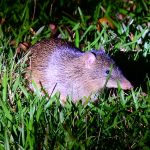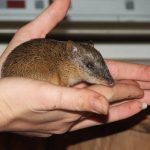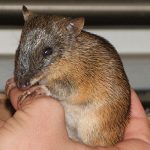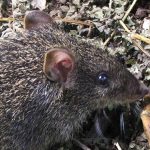NORTHERN BROWN BANDICOOT
The Northern Brown Bandicoot
The Northern Brown Bandicoot is a small, robust marsupial with a distinctive and endearing appearance. Its coarse, bristly coat is a mottled blend of warm browns and fine black speckles, perfectly suited for blending into the dappled shadows of the forest floor or the muted tones of dry grasslands. The underbelly is paler, often a creamy or soft white, providing a gentle contrast to its earthy tones. It has a pointed snout, well-adapted for probing into soil and leaf litter, small rounded ears that twitch at the slightest sound, and a short, tapered tail that aids balance as it darts from cover to cover.
Range and Habitat
This adaptable species is found across much of northern Australia, from the rugged Kimberley region of Western Australia, through the open woodlands and savannas of the Northern Territory, and into the tropical and subtropical regions of Queensland. They thrive in diverse environments — grasslands rich in insect life, eucalypt woodlands with abundant leaf litter, and even the fringes of suburban gardens, provided there is dense ground cover to shield them from predators.
The presence of these bandicoots often goes unnoticed, as they move quietly and blend seamlessly with their surroundings.
Diet and Ecological Role
The Northern Brown Bandicoot is an omnivorous forager and an important player in maintaining healthy ecosystems. They use their strong forelimbs and sharp claws to dig small conical holes in search of insects, beetle larvae, earthworms, and other invertebrates. This digging not only unearths their food but also aerates the soil, improving its health and helping native plants to thrive.
Their diet also includes fruits, seeds, tubers, and roots. By consuming fruit and passing seeds in different locations, they act as natural seed dispersers, helping to maintain plant diversity. In this way, the Northern Brown Bandicoot functions as both a pest controller and a gardener of the bush.
Breeding and Life Cycle
One of the most remarkable traits of this species is its reproductive speed. They can breed year-round, with a peak during the wet season when food is plentiful. After a gestation of just 12 days — one of the shortest among mammals — the female gives birth to up to four tiny, underdeveloped young. These joeys crawl into the mother’s pouch, where they remain safe and nourished for around two months before emerging to explore.
In the wild, their life expectancy is generally two to three years, though they can live longer in captivity where threats such as predators and food scarcity are reduced.
Behaviour and Communication
Northern Brown Bandicoots are mostly nocturnal, emerging under the cover of darkness to forage. During the day, they rest in shallow nests of grass and leaves, hidden beneath dense vegetation. They are generally solitary, except during mating or when a mother is raising her young.
While they are quiet animals, they can produce soft grunts, snuffles, and squeaks, particularly when foraging or interacting. Their quick reflexes and bursts of speed allow them to evade danger — darting into cover at the first sign of a predator.
Conservation Status and Threats
Currently listed as Least Concern by the International Union for Conservation of Nature (IUCN), the Northern Brown Bandicoot remains relatively widespread. However, they face increasing pressures from habitat loss due to land clearing, as well as predation by introduced species such as cats and foxes. Vehicle strikes and changed fire regimes also pose risks to their populations.
Conservation strategies focus on:
- Protecting and restoring native vegetation
- Managing feral predator populations
- Raising community awareness about the role of bandicoots in healthy ecosystems
By safeguarding their habitat, we not only protect the bandicoots but also the many plant and animal species that depend on the same landscapes.




